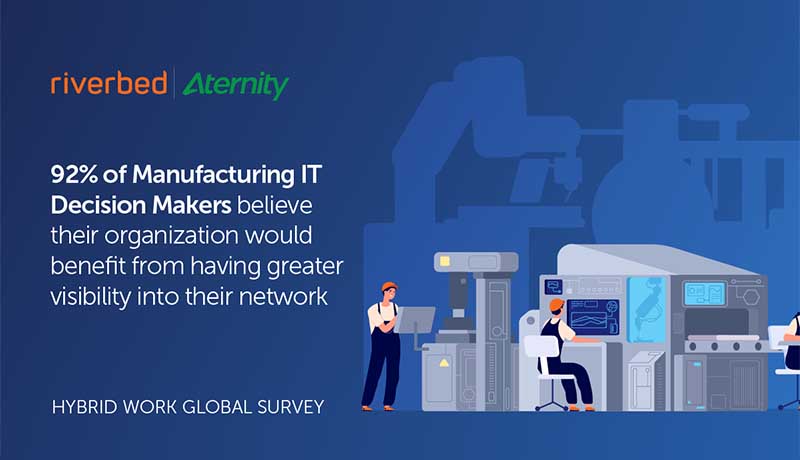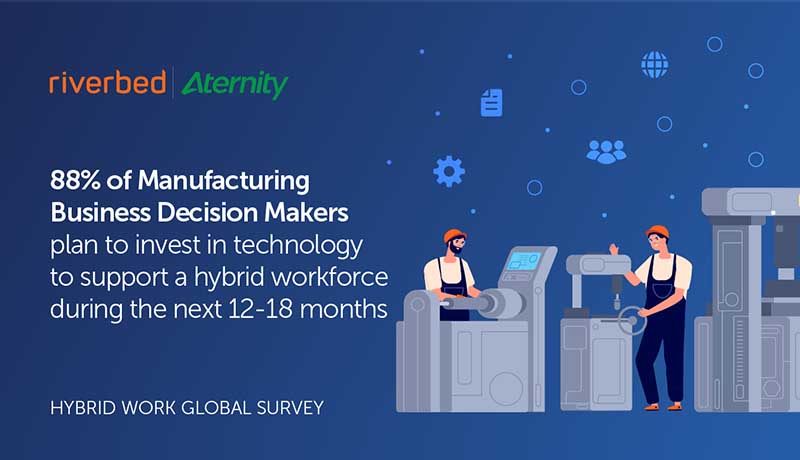
Riverbed | Aternity reveals that 51% of business decision makers (BDMs) in the Manufacturing industry believe that half (50%) of their workforce will remain hybrid post-pandemic. Furthermore, the vast majority of Manufacturing BDMs (96%) believe that a hybrid structure would help them recruit talent and remain competitive. These are two key findings from the Riverbed | Aternity Hybrid Work Global Survey, which investigates the state of hybrid working and identifies the key investment areas and technologies needed to create long-term, high-performing workplaces.
Offering a seamless hybrid-working environment is no longer a nice-to-have, but a business priority as the Manufacturing sector recovers from COVID-19. However, only one-third (33%) of Manufacturing IT Decision Makers (ITDMs) believe their current IT estate is fully prepared to meet the demands of long-term hybrid work. As a result, 85% of Manufacturing BDMs are concerned about a difference in network and application performance between hybrid or remote employees and in-office employees. In response, 92% of ITDMs and 88% of BDMs in the manufacturing industry say they intend to invest in technology to support a hybrid workforce over the next 12-18 months.
Commenting on the report findings, Mena Migally, Regional Vice President, META at Riverbed | Aternity, said, “During the last two years, the pandemic has had a significant impact on the Manufacturing sector across the globe, as businesses have had to shift much of their operations to a remote and hybrid working model. For a sector where employees don’t traditionally work remotely, these changes have presented an opportunity for manufacturers to take a significant leap forward in their digital transformation journey. Manufacturers have not only adopted new technologies that will give them a competitive advantage, but increasingly are leveraging visibility and observability solutions to deliver actionable insights that drive business performance and an exceptional digital experience. Especially with the global supply chain disruption, the ability to support a remote workforce can translate to increased productivity as employees can operate from anywhere and at any time. As a result, manufacturers across the META region are working to create environments that will be productive, collaborative and attract the talent that will set their business apart now and into the future.”

The Riverbed | Aternity report revealed that creating sustainable and high-performing hybrid workplaces are critical for business success, and reliant on organizations addressing both human-and technology-related barriers. According to Manufacturing ITDMs, the top five barriers to adopting a sustainable hybrid work model are:
Manufacturing BDMs agree that collaboration and virtual relationship building (31%) is also one of their biggest barriers to adopting hybrid working across their organization. However, 35% cite poor home/remote network performance as the main reason.
Furthermore, BDMs believe that if we don’t act now, manufacturers will begin to fall behind other sectors. Issues such as Wi-Fi not working properly (46%), the inability for employees to connect to corporate networks (41%) and increased network traffic/bandwidth consumption and unreliable application performance (31%), will all have a huge impact on the ability to provide hybrid working over the next 12-18 months.
To identify and troubleshoot these issues, manufacturers need greater visibility and actionable insights. ITDMs identify the top five challenges with current visibility/monitoring solutions as:

The majority of Manufacturing ITDMs (92%) agree that their organizations would benefit from having greater visibility into their networks and systems to identify performance or security risks. And 89% believe there should be more investment into performance and acceleration solutions that will help them to increase productivity and allow them to create the experiences that will attract more talent to the sector.
It’s encouraging that 92% of Manufacturing ITDMs and 88% of BDMs agree and are committed to investing in new technologies to support a hybrid workforce during the next 12-18 months. Their top areas of technology investments will be:
“In 2022, the Manufacturing sector must move forward and take positive learnings from the last year of change. By implementing unified observability, full-fidelity visibility and acceleration technologies, they will be able to attract new talent, create new opportunities and build a productive and happy workforce, with hybrid at its core,” concludes Migally.
Download the full Riverbed | Aternity Hybrid Work Global Survey report here and view the infographic here.